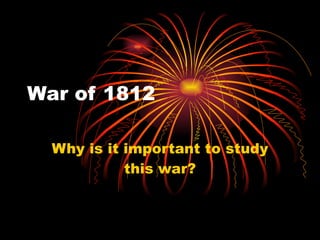War of 1812
- 1. War of 1812 Why is it important to study this war?
- 2. Ėý
- 3. Causes of the war Impressment by British troops Even though the Impressment act was repealed, word did not reach America before the attack on Canada. How could this be? In pairs, discuss whether or not impressment could happen today, and the reactions you think different people would have. Share your ideas with the class by writing on the chart papers labeled with the various people groups considered. Attack and burning of Canadian Parliament by American soldiers.
- 4. Battenburg Races British soldiers suffered heat stroke from chasing American soldiers at Battenburg when they were retreating. In partners, Investigate the symptoms and treatment of heat stroke. Brainstorm: What are some reasons that the British soldiers would have suffered from it while the Americans did not? Report your findings back to the class.
- 5. Examine the spatial characteristics: Why is Baltimore a good choice for a fort? What makes it a good choice? Use the map to support your opinion. In the War Journal , write a 2 paragraph ânews reportâ explaining why the Americans are going to build a fort in Baltimore. You will be writing this news report as if you lived in the time period. Include who, what, when, where, why, and how. Donât forget to include your supporting evidence. Save your War Journal to the desktop to finish later.
- 6. Practice your math skills. Use the map of Fort McHenry. Calculate the perimeter. If cannons are placed every 20 feet along the walls, how many cannons are required? Record your results in the War Journal
- 7. Investigate the people: President James and Dolly Madison General Ross How did his death change the battle? Francis Scott Key Read the poem What does this tell you about the hearts of the citizens of America at the time? Explore the flag What special techniques were used?
- 8. Summarizing : Create a comic strip (to be included on the back page of the War Journal) to demonstrate what you learned from investigating the people, poem, and flag. You do not have to include information from all of the investigations. You must have 4 frames (more is acceptable). You must use colored pencils to bring color to your strip. There must be enough writing in the strip so that the reader understands what you learned. The work must be neatly done .
- 9. Create a Timeline Include important events in the War of 1812. You MUST include: the attack on Canada the Battle of Baltimore and the Battle of New Orleans. Include enough events in the timeline to show the class why these three battles are significant.
- 10. The 1812 Overture What was the original reason for the composition of this piece? Why is it so attractive to Americans? Listen to the piece (click on the black box). What instruments or sound effects do you hear that explain why Americans have chosen it as their favorite 4 th of July melody? Pretend you are the music critic for the War Journal. Write up a short piece about this new composition and how it reflects the feelings of the Americans during the war. When you go to the next slide, notice how the music and visual effects of the fireworks display complement each other. Click on black box, here:
- 11. Ėý
- 12. When finished, click to return
- 13. When finished, click to return
- 14. Gardnerâs MIâs In the first activity, students are asked to discuss in pairs and then write on chart paper, the results of their discussions. This reaches the interpersonal, linguistic, and bodily/kinesthetic intelligences. The second activity is a brainstorming activity that takes place after the student pairs investigate heat stroke. This activity uses interpersonal, linguistic, and bodily kinesthetic, since they are reading, discussing, and using the computer keyboard and mouse to get to the appropriate site to do the investigation. When students examine the spatial characteristics of Baltimore harbor and placement of a fort, they are using spatial intelligence. They have to create a newspaper report as if they lived in the period, requiring them to be able to write from the point of view of a Baltimorean. This exercises their linguistic intelligence, and the fact that they have to type it, exercises the kinesthetic intelligence. When students practice their math skills, they are asked to calculate perimeter and placement of cannons on the walls of Fort McHenry. This exercises spatial, mathematic/logical, and kinesthetic, since they have to again type this into the journal. When the students complete the summarizing activity, they will be exercising their spatial intelligence as they create a comic strip. Linguistic and kinesthetic are met in the writing and creation of the strip. Spatial, linguistic, kinesthetic and logical intelligences are required to complete the time line. Musical, linguistic, kinesthetic, and interpersonal intelligences are required when looking at the composition, the 1812 Overture .













